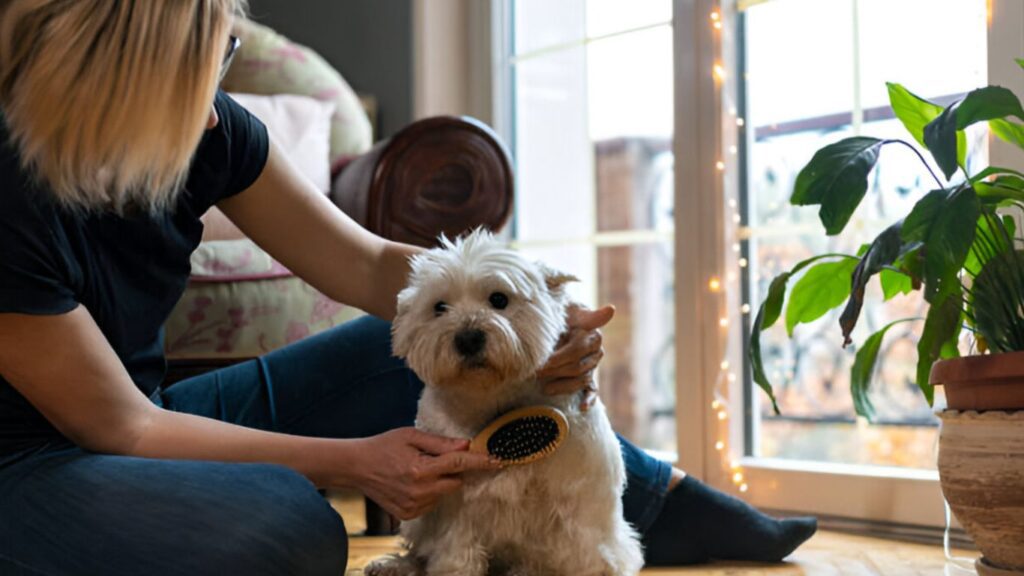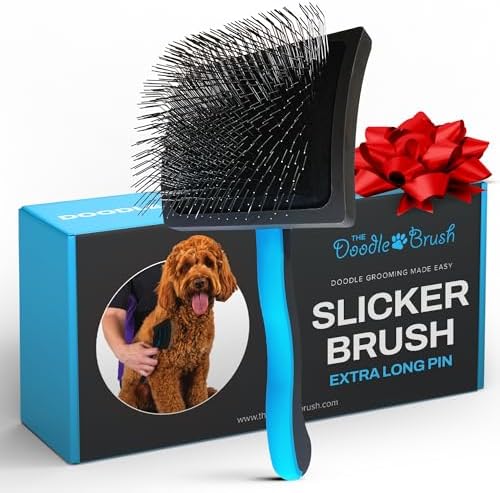If your dog is frightened or screams and bites when they see the brush, you’re certainly not alone. So, if your question is, “Why does my dog hate being brushed?” There are many reasons some dogs are resentful of grooming.
It’s more than a means to keep their coat looking nice. It’s an essential element of responsible dog care. Regular grooming can help you keep track of the overall health of your dog by providing you with the opportunity to identify dog skin issues or parasites. You can also look for any odd lumps or bumps. But some dogs are not fond of being groomed.
Maintaining your Golden Retriever’s coat in optimal condition requires the right grooming products. Using a high-quality, breed-specific shampoo can help maintain their luscious fur and prevent skin issues. Check out this Shampoo for Golden Retrievers for shiny hair to ensure your pet’s coat stays clean, soft, and well-nourished.
What Are The Reasons Behind Your Dog’s Dislike for Brushing?
Here’s your answer to why my dog hates being brushed: Some dogs are uncomfortable being groomed because of past experiences or anxiety, skin sensitivities, or a lack of patience. Understanding the reasons behind this will benefit from taking your grooming time and, with consideration, making the process more pleasant for your pet.

1. Negative Past Experiences
The dog’s memory is excellent, particularly in relation to bad events. If your dog has been groomed too roughly or experienced an unpleasant experience during grooming, it might think of the experience as discomfort. This is especially true for puppies since early experiences shape their socialisation and learning. If you’re wondering, Why Does My Dog Hate Being Brushed, past negative encounters could be the reason.
2. Anxiety and Fear
Anxiety plays a major influence on how dogs respond to grooming. For certain dogs, the experience of new things, such as being brushed, could be overwhelming. When your pet is nervous or anxious, brushing can intensify the anxiety and cause severe fear. In addition, if your dog has experienced any trauma or experiences in the past, even ones that aren’t related to grooming, they could be a contributing factor to the fear that they have of being groomed.
3. Sensitivity and Pain
Some dogs have extremely sensitive skin, making brushing painful. If your dog flinches or turns away when you begin to brush, it may be trying to avoid discomfort. This can leave many pet owners wondering, “Why Does My Dog Hate Being Brushed?” In these instances, it is crucial to be patient and gentle and use the right tools and methods to reduce discomfort.
4. Lack of Patience
Some dogs have boundless energy and struggle to sit still for grooming sessions. If your pet constantly wants to run and play, brushing may seem like a chore to them. However, regular grooming is essential to keep shedding under control. Using a grooming brush to reduce shedding in short-haired dogs can make the process easier and more effective, helping maintain a smooth and clean coat.
How to Brush a Dog That Dislikes Being Brushed?
Knowing why does my dog hate being brushed can be the first step to making grooming more enjoyable. If you are patient, you can combine the right method and a few helpful suggestions to help your dog become more comfortable when brushing.

1. Create a Positive Environment
Create a calm and positive space to groom your dog. Find a peaceful area in which your dog is safe and ensure that it is at ease. To relax, you can place your dog on a comfortable surface, such as a bed or towel. It’s also beneficial to confine them to an enclosed space where they aren’t able to escape easily, like an outdoor patio or even a tiny space.
2. Use Treats and Positive Reinforcement
Treats can be a great way to encourage the dog to behave well during grooming. Begin by having your dog take a sniff of the brush, then give them the treat. Continue to reward them throughout the grooming process to help reinforce positive interactions with the groomer. At first, it is possible to offer a treat every couple of seconds to keep them interested and engaged.
3. Start Slow and Be Gentle
When you’re brushing a dog that isn’t enjoying brushing, having patience is essential. Start by cleaning tiny, easily accessible areas of your pet’s coat. Concentrate on areas where your dog does not mind being brushed, and try to keep the brushing sessions short. If your dog seems to be comfortable, then gradually increase the length of brushing sessions. Try to get more areas covered. Always keep it gentle, together with slow, smooth strokes, so as to not cause any discomfort.
4. Use the Right Tools
If your dog is prone to dislike a traditional brush, try other grooming tools. A grooming glove that lets you groom your pet while rubbing them could be ideal. This technique is more relaxing and less intimidating for dogs who do not want to be cleaned with a regular brush.
5. Practice Makes Perfect
It’s fine if you brush only a small portion of your dog’s coat at first. It’s important to gradually increase your dog’s trust and bath time. As your dog relaxes, you’ll be able to scrub more areas throughout every session. Make sure to end the session with a positive attitude and give your dog plenty of hugs and treats.
6. Consistency Is Key
Consistency is essential in building trust. Based on your dog’s coat and requirements, set up a regular grooming schedule, whether it’s every week, weekly, or bi-weekly. If your dog is aware of what is expected and when it’s expected, the experience will be much less stressful and more predictable. With time, it can turn into an enjoyable routine that your dog looks forward to.
7. Pay Attention to Your Dog’s Cues
Being aware of your pet’s body language while grooming is vital. If your pet displays indications of stress or discomfort, such as being withdrawn, grinning, or tensing, you should stop for a moment. Forcing your dog to endure grooming sessions when they’re clearly unhappy could undermine the confidence you’re attempting to create. Instead, stop the grooming session and repeat it later after your pet is more relaxed.
8. End on a Positive Note
End grooming sessions with a smile, regardless of whether the session was short or your dog was a bit difficult the day before. If you’ve ever wondered, Why Does My Dog Hate Being Brushed?, creating positive associations can help. Your dog deserves a favourite snack, a few extra cuddles, or playful time right after grooming. This will benefit your dog; associating the final moments of grooming with something they love will leave the dog with an optimistic memory of the event.
Siberian Huskies have a thick, double-layered coat that requires regular maintenance to prevent matting and excessive shedding. To keep their fur in top condition, using a recommended detangling brush for Siberian Huskies is essential. The right brush helps remove loose undercoat hair while keeping the topcoat smooth and healthy.
How to Handle a Dog’s Severe Reactions?

Your dog bites during brushing
While most dogs are taught to be tolerant of brushing, some dogs may respond more strongly by screaming or biting. This is not only unacceptable but can also be risky. If your dog bites while grooming, it is crucial to resolve the problem as soon as possible.
1. Seek Vocational Help
If your dog becomes aggressive while grooming, consulting a competent dog trainer may be beneficial. A dog trainer can help you discover the source of your dog’s behaviour and develop strategies to deal with it. Furthermore, a competent groomer who is skilled in dealing with fearful or aggressive dogs will ensure the safety of grooming for the pet and you.
2. Rule Out Medical Issues
Sometimes, a dog’s tendency to bite during grooming may be a sign of a medical condition. Problems such as joint inflammation, arthritis, or skin conditions can cause pain when grooming your pet. In the event that your dog begins chewing on its grooming or appears to be experiencing discomfort, it’s a great idea to talk with your vet. They will help identify any health issues and suggest appropriate treatment or adjustments in your routine. When grooming a Cane Corso, finding the best brush for a Cane Corso can make a significant difference in keeping their coat looking its best and their skin healthy.
Alternatives to Brushing: Other Ways to Direct Your Dog’s Coat
If brushing can be stressful for your dog, there are other methods for controlling its coat and ensuring it looks excellent.

1. Regular Bathing
Regularly bathing your dog will help shed loose hair and reduce the amount of shedding. While baths can’t replace brushing completely, they can be an excellent supplement, particularly for dogs with short coats. Make sure you use a pet-friendly shampoo and conditioner to ensure that your dog’s coat and skin are healthy.
2. Exercise Before Grooming
If your dog doesn’t like being slouchy, try dragging it out prior to cleaning. After an hour of walking, playtime, or agility exercises, the dog might be more relaxed and allow you to brush it. This could help make the process less stressful and more enjoyable for you both.
3. Puzzle Toys and Distractions
If treats on their own do not seem satisfying for keeping your pet safe when grooming them, you can try the puzzle toy packed with treats. These toys will keep your dog busy and entertained while you groom them, which makes the process less stressful.
Short-haired dogs still require regular grooming, and using the best brush for short hair dogs will ensure their coat stays sleek and free from loose fur.
Conclusion:
Brushing is an important element of grooming your dog. However, it’s not always easy, especially if your pet is reacting negatively to it. Knowing the causes of the dog’s displeasure with brushing, with positive reinforcement, and a willingness to be patient can make an enormous impact. With practice, time, and the correct approach, your dog can enjoy being brushed, transforming the once-stressful chore into an enjoyable experience that you both love. I hope so; now you know why my dog hates being brushed.




